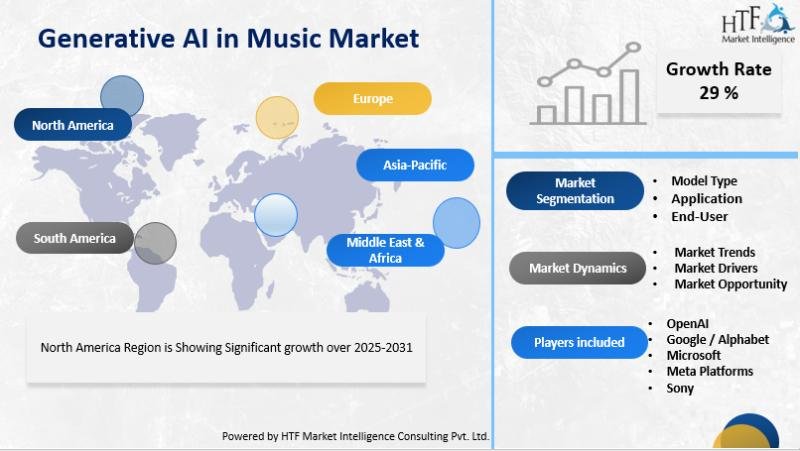HTF MI just released the Global Generative AI in Music Market Study, a comprehensive analysis of the market that spans more than 143+ pages and describes the product and industry scope as well as the market prognosis and status for 2025-2031. The marketization process is being accelerated by the market study’s segmentation by important regions. The market is currently expanding its reach.
Major companies in Generative AI in Music Market are: OpenAI (United States), Google / Alphabet (United States), Microsoft (United States), Meta Platforms (United States), Sony (Japan), Universal Music Group (United States), Shutterstock Inc. (United States), Aiva Technologies SARL (Luxembourg), Boomy (United States), Soundful (United States), Ecrett Music (Japan), Amper Music (United States), Amadeus Code (United States), LANDR Audio (Canada), Stability AI (United Kingdom), Udio (United States), Soundraw (Japan), Vochlea Music (United Kingdom), Hydra II by Rightsify (United States), Beatoven AI (United States), Moises Systems Inc. (United States), Mubert (United Kingdom).
Get Customized Sample Now 👉 https://www.htfmarketintelligence.com/sample-report/global-generative-ai-in-music-market?utm_source=Krati_OpenPR&utm_id=Krati
According to HTF Market Intelligence, the global Generative AI in Music Market size was valued at USD 570 Million in 2024 and estimated to reach revenue of USD 3388Million by 2031, with a CAGR of 29% from 2025 to 2031.
The Generative AI in Music Market is Segmented by Application (Automated Music Composition, Music Mastering and Mixing, Sound Design and Synthesis, Style Transfer and Remixing, Personalized Recommendation) by Model Type (Transformer-Based Models, Generative Adversarial Networks (GANs), Variational Autoencoders (VAEs), Diffusion Models, Others) by Component (Software Platforms, Services) by End-User (Music Production and Recording, Film, Television and Advertising, Video Games and Interactive Entertainment, Streaming Platforms and Publishing, Music Education and Training, Other)
Definition:
Generative AI in music refers to the application of artificial intelligence algorithms-especially generative models-to compose, arrange, and produce music autonomously or collaboratively with humans. These systems use machine learning techniques, including neural networks trained on large datasets of music, to generate melodies, harmonies, rhythms, and even full compositions. Applications span music production, film scoring, advertising jingles, and personalized playlist creation. Beyond composition, AI can adapt music in real time based on listener mood, gameplay dynamics, or environmental factors. This technology is reshaping creative workflows, lowering production barriers, and opening new forms of musical expression.
Market Trends:
Use of large language models for lyric creation, AI‐generated adaptive game and film soundtracks, and real‐time collaborative AI music tools are trending.
Market Drivers
Rising adoption of AI‐driven tools for music composition, production automation, and personalized soundtracks is fueling growth.
Market Opportunities:
Licensing AI‐generated music for content creators, integrating AI with music streaming platforms, and developing custom AI music APIs present large opportunities.
Market Restraints:
Market Challenges:
Copyright concerns, ethical questions over AI‐created works, and resistance from traditional musicians are challenges.
Dominating Region:
North America
Fastest-Growing Region:
Asia‐Pacific
Have a query? Market an enquiry before purchase 👉 https://www.htfmarketintelligence.com/enquiry-before-buy/global-generative-ai-in-music-market?utm_source=Krati_OpenPR&utm_id=Krati
The titled segments and sub-section of the market are illuminated below:
In-depth analysis of Generative AI in Music market segments by Types: Transformer-Based Models, Generative Adversarial Networks (GANs), Variational Autoencoders (VAEs), Diffusion Models, Others
Detailed analysis of Generative AI in Music market segments by Applications: Automated Music Composition, Music Mastering and Mixing, Sound Design and Synthesis, Style Transfer and Remixing, Personalized Recommendation
Global Generative AI in Music Market -Regional Analysis
• North America: United States of America (US), Canada, and Mexico.
• South & Central America: Argentina, Chile, Colombia, and Brazil.
• Middle East & Africa: Kingdom of Saudi Arabia, United Arab Emirates, Turkey, Israel, Egypt, and South Africa.
• Europe: the UK, France, Italy, Germany, Spain, Nordics, BALTIC Countries, Russia, Austria, and the Rest of Europe.
• Asia: India, China, Japan, South Korea, Taiwan, Southeast Asia (Singapore, Thailand, Malaysia, Indonesia, Philippines & Vietnam, etc) & Rest
• Oceania: Australia & New Zealand
Read Detailed Index of full Research Study at 👉 👉 https://www.htfmarketintelligence.com/report/global-generative-ai-in-music-market
Generative AI in Music Market Research Objectives:
– Focuses on the key manufacturers, to define, pronounce and examine the value, sales volume, market share, market competition landscape, SWOT analysis, and development plans in the next few years.
– To share comprehensive information about the key factors influencing the growth of the market (opportunities, drivers, growth potential, industry-specific challenges and risks).
– To analyze the with respect to individual future prospects, growth trends and their involvement to the total market.
– To analyze reasonable developments such as agreements, expansions new product launches, and acquisitions in the market.
– To deliberately profile the key players and systematically examine their growth strategies.
FIVE FORCES & PESTLE ANALYSIS:
In order to better understand market conditions five forces analysis is conducted that includes the Bargaining power of buyers, Bargaining power of suppliers, Threat of new entrants, Threat of substitutes, and Threat of rivalry.
• Political (Political policy and stability as well as trade, fiscal, and taxation policies)
• Economical (Interest rates, employment or unemployment rates, raw material costs, and foreign exchange rates)
• Social (Changing family demographics, education levels, cultural trends, attitude changes, and changes in lifestyles)
• Technological (Changes in digital or mobile technology, automation, research, and development)
• Legal (Employment legislation, consumer law, health, and safety, international as well as trade regulation and restrictions)
• Environmental (Climate, recycling procedures, carbon footprint, waste disposal, and sustainability)
Buy Now Latest Edition of Global Generative AI in Music Market Report 👉 https://www.htfmarketintelligence.com/buy-now?format=1&report=16065?utm_source=Krati_OpenPR&utm_id=Krati
Points Covered in Table of Content of Global Generative AI in Music Market:
Chapter 01 – Generative AI in Music Executive Summary
Chapter 02 – Market Overview
Chapter 03 – Key Success Factors
Chapter 04 – Global Generative AI in Music Market – Pricing Analysis
Chapter 05 – Global Generative AI in Music Market Background or History
Chapter 06 – Global Generative AI in Music Market Segmentation (e.g. Type, Application)
Chapter 07 – Key and Emerging Countries Analysis Worldwide Generative AI in Music Market
Chapter 08 – Global Generative AI in Music Market Structure & worth Analysis
Chapter 09 – Global Generative AI in Music Market Competitive Analysis & Challenges
Chapter 10 – Assumptions and Acronyms
Chapter 11 – Generative AI in Music Market Research Method
Thanks for reading this article; you can also get individual chapter-wise sections or region-wise report versions like North America, LATAM, Europe, Japan, Australia or Southeast Asia.
Nidhi Bhawsar (PR & Marketing Manager)
HTF Market Intelligence Consulting Private Limited
Phone: +15075562445
sales@htfmarketreport.com
About Author:
HTF Market Intelligence Consulting is uniquely positioned to empower and inspire with research and consulting services to empower businesses with growth strategies, by offering services with extraordinary depth and breadth of thought leadership, research, tools, events, and experience that assist in decision-making.
This release was published on openPR.















